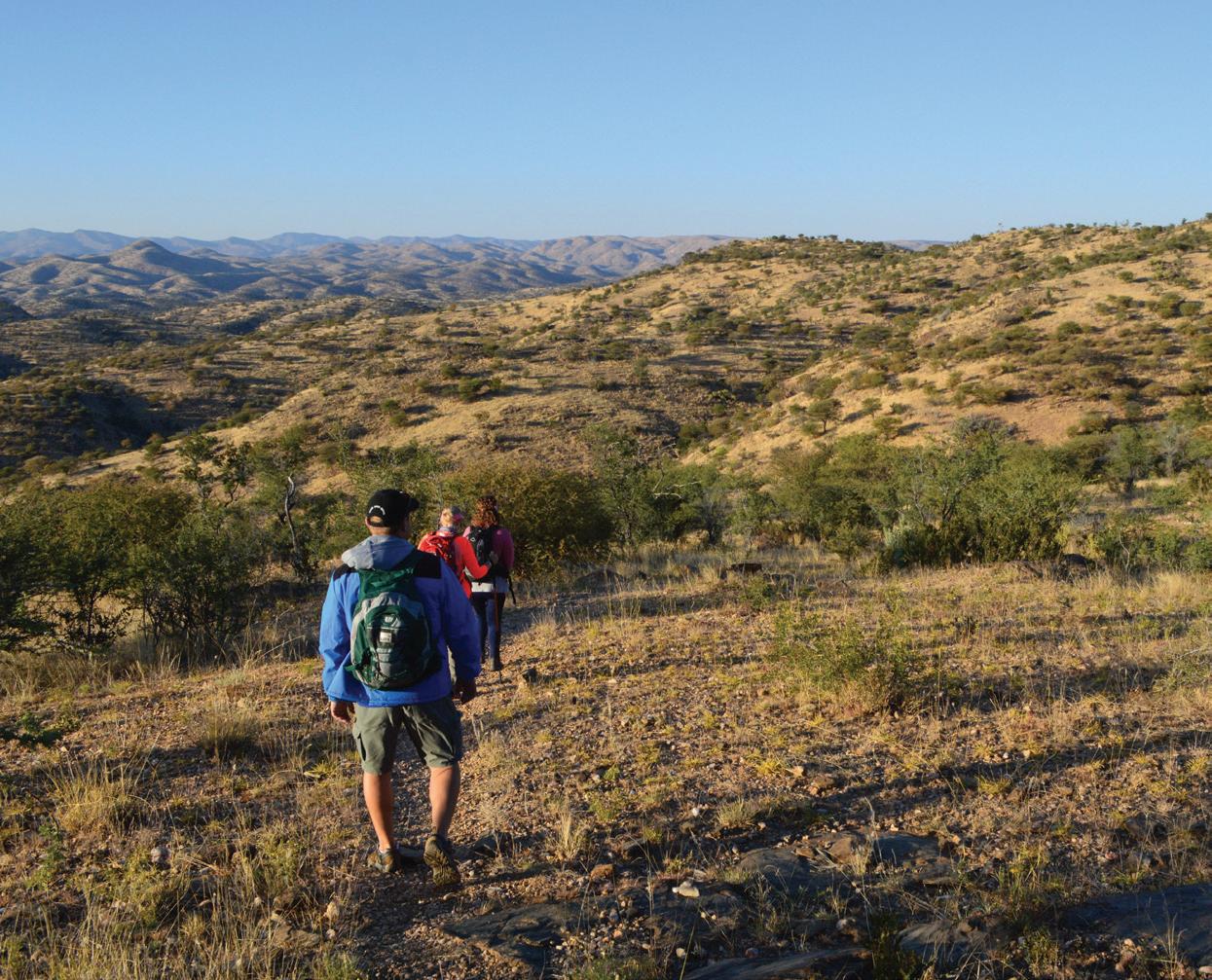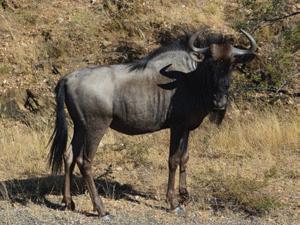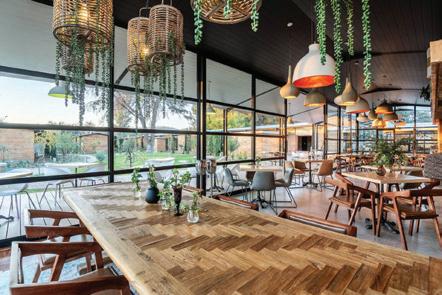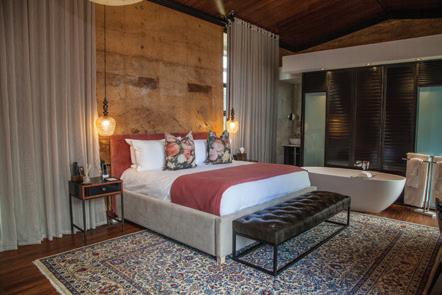
9 minute read
DAAN VILJOEN Tackle the Rooibos Trail
Daan Viljoen is so close (to Windhoek) Tackle the Rooibos trail
Text and Photographs Willie Olivier
Soon after setting off on the 9 km Rooibos Trail in the Game Reserve on a chilly morning, we stopped in our tracks as we spotted a herd of blue wildebeest heading to the waterhole beyond the office.
After watching their antics for a while we continued along a dry river course for about one kilometre where a signpost directed us to turn left. From here we ascended steadily and paused to catch a fleeting glimpse of a gemsbok (Oryx gazella) that took flight but stopped to look at us once it felt safe.
The trail took us through thornveld savannah vegetation, a mosaic of thorn trees and other species, including the red bush willow or rooiboswilg (Combretum apiculatum) after which the trail has been named. In Namibia it is commonly referred to as the kudu bush or koedoebos – a reference to the popularity of its leaves with kudu and other wildlife. Some of the trees along the trail bear name tags, making it easy for those unfamiliar with Namibia’s plants to identify them.

White-tailed Shrike
TICK OFF 200 BIRDS With a checklist of over 200 species, Daan Viljoen offers exciting birding opportunities, including several nearendemic species. Rüppell’s Parrot, Monteiro’s Hornbill, Carp’s Tit, Rockrunner, White-tailed Shrike and Violet Woodhoopoe are among the noteworthy species that have been recorded in the park.
Our first destination, a trigonometric beacon 1 783 m above sea level, was reached sooner than we had anticipated. The beacon marks the highest point of the park and lent itself as the ideal place to have a cup of coffee while we enjoyed the spectacular 360 degree view. To the east we looked down on the Windhoek valley and the sprawling city while the rolling hills of the Khomas Hochland unfolded around us. We counted ourselves lucky as there was a small group of Hartmann’s mountain zebra and two blue wildebeest in the valley below us and a few minutes later, three gemsbok appeared. The game reserve’s kudu, red hartebeest, springbok and giraffe unfortunately evaded us.
After a short break we shouldered our day packs to tackle the next leg of the trail which meanders downhill for quite some way before climbing up to a ridge. A long steady descent along another ridge followed with some sections that needed to be approached with caution – largely because of the loose gravel.
About 45 minutes after leaving the beacon, we arrived at a river bed which is usually dry. We crossed the river course several times and decided to take another short break to top up our energy levels with some nuts and raisins, biltong (good protein) and some energy bars. After following the river bed for about 30 minutes we came to a jeep track, but after just a few metres a signpost directed us to turn left. A steep uphill slog of 20 minutes awaited us until we emerged at the old restaurant complex.
An easy 15 minute walk along a tar road took us past the Augeigas Dam back to the start, just over three hours after setting off. The dam with its 31.5 m high wall was built in 1933 following the devastating drought of 1931/2. A rich variety of waterbirds, as well as game, are attracted to the dam when it contains water. But unfortunately it had received little inflow during the past rainy season and we saw only a solitary duck on what little water was left.
WAG-'N-BIETJIE TRAIL The Wag-'n-Bietjie Trail is a shorter and easier option, suitable for families with children. Starting near the office, the trail follows a dry river course for 1.5 km to the Stengel Dam which is usually dry after poor summer rains, but after a good rainy season the dam attracts a variety of birds. The trail owes its name to the common Afrikaans name of the buffalo thorn: ‘Wag-'n-bietjie’, which means ‘wait a bit.’ As the name suggests, you can easily get caught up in the sharp, hooked thorns on its branches. TNN
DID YOU KNOW?

• The park is only 25 km outside the capital and open throughout the year. Day visitors have access between 06h00 and 18h00. • An entrance fee is payable at the office. • Visitors over 16 years: Foreign N$ 40; SADC citizens N$ 30; Namibians N$ 10; Sedan vehicles N$ 10. The office opens at 06h30 and hikers are required to sign in before setting off and to sign out after completing the trail. • A fee which varies seasonally is payable by day visitors using the Boma Restaurant and other facilities of Sun Karros. Bona fide hikers who enter the park before 10h00 are not required to pay the Boma Day Visitor fee. Sun Karros, however, reserves the right of admission. • A map of the trail is available at the Ministry of Environment and Tourism office in the park.

Liza de Klerk


Droombos A Culmination of Perfection

A culmination of perfection is what comes to mind when visiting Droombos, an exclusive lodge that refuses to be associated with the ordinary. And rightly so. Situated only a few minutes drive outside Windhoek, Droombos brings a unique flair to celebrations of any kind. Whether it's celebrating birthdays, weddings or the beauty of Droombos by staying in one of the luxurious rooms, the dream-like atmosphere of the manicured gardens and towering ancient trees will enchant you. Droombos creates an opulent setting that is a perfect eclectic balance between nature, self-sustainability and luxury.
RAMMED EARTH WALLS Using an ancient technique, most of the structures at Droombos are built with rammed earth walls. The first examples of this building style were found in excavations at Jericho dating back to 8 300 BC. Rammed earth walls also make up a part of the Great Wall of China, and the Romans, too, used this method extensively. Although the history is fascinating, it is not the reason why this well established technique was used at Droombos. It's the environmentally friendly way of building that fits in with the establishment’s core values. Furthermore, the instantly recognisable red kalahari sand that is used provides an earthy backdrop which is not only natural but compliments the wonderfully laid out gardens around the lodge.
24 WWW.TRAVELNEWSNAMIBIA.COM are completely non-toxic, non-polluting and they breathe naturally. This means safer, people-friendly buildings that are low in embodied energy and extremely comfortable to live in. The thickness and density efficiently cuts out external noise which ensures an excellent sleep, free of disturbance.
THE GARDEN Without a doubt the stars of the gardens are the two massive camel thorn trees which are both more than 500 years old. Silent guardians that provide shade for the events arranged on the lush green lawns beneath the long branches of their green canopy. The large garden is a small paradise not only for birds but it is also a popular space to host specialised events. The 100 poplars, 140 apple trees, massive blue gums, wild figs and a number of cherry and wild mulberry trees create a garden unlike any other in Namibia. Additionally, the vegetable and herb gardens don't just add


to the diversity of plants in this green space, but supply the restaurant with the freshest produce, straight from the land. The lawns and ample shade make the garden perfect for lazy Sunday picnics, but it is similarly ideal for baby showers, kitchen teas and birthday celebrations.
LUXURY ACCOMMODATION Each room has its own personality and is named after one of the plants in the garden. The beautiful rammed earth walls are complemented by rosewood ceilings and floors. The spacious suites each have extra-long king-size beds, covered in lush Egyptian cotton, and a gorgeous bath that will rejuvenate travellers after a long flight or eventful Namibian safari.
THE PERFECT VENUE Suitable for everything from conferences, corporate functions, weddings, celebrations to baby showers, Droombos is the perfect location where your dreams will become a reality. With the range of venue options at Droombos, every event is covered.
THE BLACK BARN Accommodating more than 500 people, the Black Barn is a large contemporary building that was intentionally designed to be versatile and can effortlessly be adapted to host any type of event from corporate functions to weddings to product launches. Its large side doors open onto a wooden deck that overlooks the well-manicured old camel thorn garden.
DIE ROOIE GALLERY Don't be fooled into thinking that this is purely a gallery. As with the other function venues at Droombos this delightful rammed earth building is versatile and can be set up to your exact needs. The perfect space for an unforgettable art exhibition,


but it also works beautifully as a wedding chapel and for many other purposes. A place to celebrate all things beautiful, the Die Rooie Gallery accommodates up to 250 people.
THE LIBRARY The smallest of the venues is the Library. It has room for up to 40 people which makes it suitable for a small conference or for an intimate dinner with family and friends.
DROOMBOS RESTAURANT Large glass panels ensure a scenic 180 degree view onto the Droombos garden. Matching the view is the simple yet delicious menu. Sourcing only the finest ingredients from across Namibia as well as freshly harvested vegetables and herbs straight from the Droombos garden, guests are treated to a culinary feast. The seasonal ingredients not only create an ever-changing menu, but also ensure an environmentally friendly dining experience. The delicious treats, baked freshly every day, are enough reason to come to Droombos for coffee and cake and a quick escape from the city.
PUB AND LOUNGE This English-style pub entices with its rich rosewood ceiling, floor and bar counter complemented by inviting couches and stylish decor. It is a great place to meet friends for a drink after work or to decompress after a long day's drive.
Droombos is a celebration. It celebrates nature and our place in it. Whether gathering as family and friends to experience the union of two loved ones, a baby shower as part of the excitement of welcoming new life, or a beautifully arranged corporate function in the old camel thorn garden – make sure you have it at Droombos. TNN










